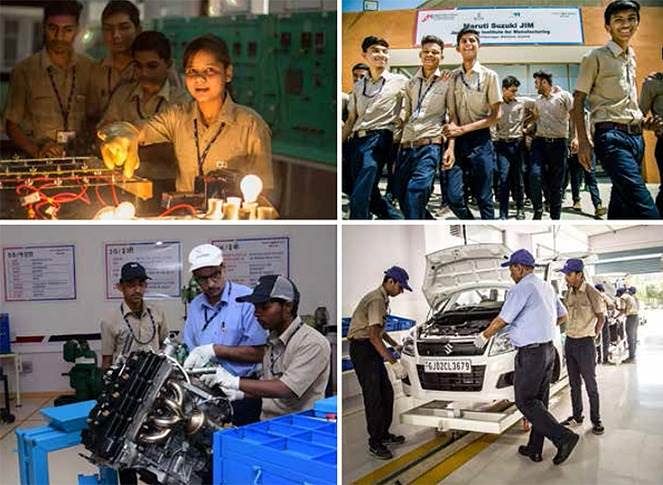Nikunj Sanghi: ‘ASDC’s ethos is not only skills – it is about developing good-quality manpower.’
ASDC, set up 10 years ago, has singularly addresses India Auto Inc’s shortage of skilled manpower. Nikunj Sanghi, who has been chairing the council in his second consecutive tenure, speaks to Autocar Pro.
The automotive industry in India is undergoing a transformation because of its sustained growth and profitability. The Indian automotive industry currently accounts for 7.1% of GDP and 49% of manufacturing output, generating 32 million direct or indirect employment. The Automotive Skills Development Council (ASDC) set up 10 years ago has come a long way in solving India Auto Inc’s problem of being skill deficit. Nikunj Sanghi, who has been chairing the council in his second consecutive tenure, speaks to Autocar Pro.
Can you recall the early years at ASDC?
The first milestone was the formation of the ASDC 10 years ago and it was a joint effort of three keyindustry bodies – SIAM, ACMA, and FADA – with the most critical support comingfrom the government of India. It’s a wonderful example of a public-private partnership (PPP) model, and the entire ecosystem getting together at this scale.
While initially our parent ministry used to be the Ministry of Heavy Industries and Public Enterprises as both auto component and vehicle manufacturers came under the ambit of the Department of Heavy Industries, during the course, there were other ministries such as the HRD and MoRTH that also got involved, and along with the NSDC (National Skill Development Corporation), became part of the governing council of ASDC.
Earlier, all the Sector Skill Councils were mandated to define standards, including defining the various roles which are there in the manufacturing industry – both vehicle and component – as well as in the sales and aftersales ecosystem. After that, there was the task of defining the national occupational standards for each of these roles, which led forward to measure them, giving birth to quality packs.
Ultimately, it was getting the ecosystem into place that would oversee assessments and finally impart certification.
Having said that, till this point, nowhere was the focus there on training and curriculum, which was left to the partners who would later get associated in this journey.There were other agencies as well which came in to play their respective roles.
So, the initial years focused on getting the entire ecosystem together and defining these roles, as well as creating a feedback mechanism.Since ASDC was one of the first Sector Skill Councils to be incorporated, right off the block we were very clear about maintaining the sanctity of the entire ecosystem by having representation from all ministries as well as partners.

What were the challenges along the way?
When we started doing all of this, we realised that funding was a big challenge. Initially, it was divided among the three partners, with the major portion coming from the government in the form of grants and soft loans through the route of the NSDC.
Moreover, while werealised that we needed the entire machinery to train and skill people, the idea that it must lead to job creation was unwritten. We started getting involved in the process of identifying training partners and ensuring that they had the right kind of infrastructure to train and certify students.
While everything was going as per plan, somewhere we realised that there was still a huge gap between number of people getting trained and those getting employed. The feedback that the Council got from employers was that they were not very happy with the quality of people coming out after certification from ASDC programmes.
How did you overcome this challenge?
This is when we dived deep and realised that we need a far more robust assessment system which would be free of any human intervention, and could be more closely monitored by the industry itself to ensure that there is no bias involved in the certification process.
That’s when ASDC started identifying assessment partners and we found out that a wing of Tata Consultancy Services (TCS) – TCSion – had the right credentials and capabilities to assess students. They had the knowledge, technology and infrastructure, and therefore, we got into a discussion with them to bring technology on board in student assessment.
But the job wasn’t as easy as it looked because firstly, they were against working in a government-funded project, and secondly, they demanded hefty charges for their technology. It took us over one-and-a-half years to convince and bring TCSion onboard.
However, this led to another challenge in the form of the number of students being able to clear the course going down dramatically with introduction of a technology-oriented process. We shared this concerning development with both NSDC and the government of India, and since there was the Ministry of Skill Development and Entrepreneurship which was in place by this time, the government acknowledged the fact and took the conscious call that quality has to be given precedence.
What has been the level of collaboration between ASDC and the auto industry?
This was actually another gap that we identified later, that although there was industry participation, it was not to the level it should be. So, if the industry needed to engage with the Sector Skill Councils, there had to be a deeper level of engagement and participation.
Therefore, through our expert groups, for instance, on manufacturing, R&D, and sales and service, we started reaching out to the entire automotive industry and its stakeholders. As a result, most of our industry partners now have representations in these expert groups.
Today, these people monitor the standards, and also help in narrowing the gap between academia and the industry. It’s been an extremely positive achievement for us and all our expert groups are now manned by industry veterans and stalwarts, who are doing a lot of deep diving into the standards laid out by the government, and we are also updating our QPs and QRPs and getting them approved by the various authorities.
How is ASDC spreading awareness about its programmes in the student community?
We have significantly improved our reach after having realised that the awareness about training courses being available, as well as the mere existence of a Sector Skill Council, were extremely poor. So, we leveraged social media to spread awareness about the Council (ASDC) and the facilities available. We also revamped our entire website. From being not user friendly and mundane, it now has all the information available towardsgetting skilled and securing employment.
The most recent step that we are going to take, is to make a listing platform which would be available from the beginning of this entire loop to the end of it. So, it would include the various jobs available in various geographies in India. This listing platform will include members – students, training partners, assessing partners and employers.
It is a gigantic task and we are trying to get this data mapped, which would allow a studentto better gauge the advantages of undertaking a particular skilling course before preparing and enrolling for it.
We are working with TCSion for this project, which is currently under beta testing, and we are hopeful of a launch sometime next year.
What are the future areas of potential collaboration?
Being concerned with the transforming future skillsets in this ever-evolving ecosystem, we have engaged with E&Y to identify the skill gaps. The report is now available for all stakeholders of the auto industry, to gauge the opportunity and invest accordingly.
We are also continuously collaborating with not just Indian players, but global players as well. For instance, we are working with the British Government under the DFI scheme, for the EV skill development programme.

Moreover, what the pandemic did was accelerate the pace of digitisation and in that accord, we have started working with a lot of technology companies, and have just rolled out a huge digital outreach campaign with Google. To enable this, we already have had a webinar series for dealer owners to make them understand why digitisation is crucial today.
In it, we have also partnered with FADA, wherein sales executives will be the ones to be using these digital tools to enhance productivity and their job outcome.We are also collaborating with tech giants Facebook and Microsoft to deliver more of such programmes, and over the next 18 months, we would digitally reach to a mass sales audience at dealerships in every nook and corner of the country. We are also laying a strong focus on vernacular content for these initiatives.
I also believe that collaborations will form a cornerstone of the entire skilling ecosystem. Not just technology providers, we will also need to partner with some vocational skilling universities, as well as current academia where vocation is part of their curriculum. We are also working with the CBSE at the school level.
Could you elaborate about the outreach programme with Google?
We had launched the programme with Google on March 10, and deliberately took it in a digital format so that people could attempt this course at their own pace. This is because the kind of facilities available to people in metros and rural areas are very different.
The content delivery is extremely simple and the entire training programme is video based and has an assessment after every level. We feel that by the time one finishes the programme, one would be well versed with the desired skill sets regarding digital sales.
We are extremely happy with the response that we have received, with SIAM members too recommending their dealer partners to make their staffers get enrolled in this programme. This could be one of the biggest outreach programmes in our country and it is a collaborative programme among the Sector Skill Councils, auto industry and stakeholders, and a technology partner like Google.
Where do you think ASDC has come and what is the way forward?
We are still in our infancy and 10 years is still a very short period for bringing about a significant change as these are all quite tall orders. But we have made the right beginning and we have taken the right path. The team at ASDC is highly motivated towards contributing to the ultimate goal of nation building.
We are nowhere even close to where we would want to be. The entire ethos of ASDC is not about providing skills, it is about having good quality manpower which will result in capital formation and nation building.
Our first and foremost task would be to make the entire skilling ecosystem technology driven, ensure standards and make our assessments as credible and transparent as possible, to make them a gold standard. Till we reach that point, we can only boast about nation building, but we still have to travel a long distance before we reach our ultimate goal.
ALSO READ
ASDC, FADA partner Google for digitisation, will train over 100,000 people
India Auto Inc has strong appetite for manpower but skill deficit looms large
55% of jobs in India Auto Inc will require radically changed skill sets by 2022: Survey
How to upskill manpower and win over automakers
Smart factories could add up to $160 billion annually to global auto industry: Capgemini
RELATED ARTICLES
TVS Celebrates 20 Years of Apache, Eyes Premium and Global Push
Marking two decades of its flagship performance brand, TVS Motor unveiled special anniversary editions on Saturday while...
Q&A: Mahindra's Nalinikanth Gollagunta on Upcoming Festive Season, 'Bold' Design Choices
Automotive Division CEO Nalinikanth Gollagunta says mid-teens growth is achievable with Roxx ramp-up, BEVs, and a resil...
Tata Hitachi’s Next Act: Mining, Exports, and Electrification to Power Growth
Under Sandeep Singh, the construction equipment maker has moved from stabilisation to a sharper strategic focus, positio...






 27 Mar 2021
27 Mar 2021
 19480 Views
19480 Views






















 Darshan Nakhwa
Darshan Nakhwa



 Yukta Mudgal
Yukta Mudgal

